Investigation of the Shear Mechanical Behavior of Sandstone with Unloading Normal Stress after Freezing–Thawing Cycles
Abstract
:1. Introduction
2. Materials and Experimental Methods
2.1. Specimen Preparation
2.2. Freeze–Thaw Cycle Test
2.3. Experimental Scheme
3. Results and Discussions
3.1. Direct Shear Test Results
3.2. Deformation
3.2.1. Displacement Histories
3.2.2. Characteristic of Displacements
3.3. Failure Pattern
4. Fracture Surface Roughness
4.1. D Roughness Parameters
4.2. Triangulated Point Cloud
4.3. Roughness Variation Rule
5. Conclusions
Author Contributions
Funding
Institutional Review Board Statement
Informed Consent Statement
Data Availability Statement
Acknowledgments
Conflicts of Interest
References
- Bi, J.; Zhou, X.P.; Qian, Q.H. The 3D Numerical Simulation for the Propagation Process of Multiple Pre-existing Flaws in Rock-Like Materials Subjected to Biaxial Compressive Loads. Rock Mech. Rock Eng. 2016, 49, 1611–1627. [Google Scholar] [CrossRef]
- Zhang, J.B.; Fu, H.L.; Hang, Z.; Wu, Y.; Chen, W.; Shi, Y. Experimental study on the tensile strength and failure characteristics of transversely isotropic rocks after freeze-thaw cycles. Cold Reg. Sci. Technol. 2019, 163, 68–77. [Google Scholar] [CrossRef]
- Zhao, Y.; Zhang, Y.; Yang, H.; Liu, Q.; Tian, G. Experimental study on relationship between fracture propagation and pumping parameters under constant pressure injection conditions. Fuel 2022, 307, 121789. [Google Scholar] [CrossRef]
- Zhou, X.P.; Niu, Y.; Zhang, Z.J.; Shen, X.C.; Zheng, Y.; Berto, F. Experimental study on effects of freeze-thaw fatigue damage on the cracking behaviors of sandstone containing two unparallel fissures. Fatigue Fract. Eng. Mater. Struct. 2019, 42, 1322–1340. [Google Scholar] [CrossRef]
- Wu, Z.J.; Fan, L.F.; Liu, Q.S.; Ma, G.W. Micro-mechanical modeling of the macro-mechanical response and fracture behavior of rock using the numerical manifold method. Eng. Geol. 2017, 225, 49–60. [Google Scholar] [CrossRef]
- Huang, S.B.; Liu, Y.Z.; Guo, Y.L.; Zhang, Z.; Cai, Y. Strength and failure characteristics of rock-like material containing single crack under freeze-thaw and uniaxial compression. Cold Reg. Sci. Technol. 2019, 162, 1–10. [Google Scholar] [CrossRef]
- Wu, Z.J.; Xu, X.Y.; Liu, Q.S.; Yang, Y. A zero-thickness cohesive element-based numerical manifold method for rock mechanical behavior with micro-voronoi grains. Eng. Anal. Bound. Elem. Methods 2018, 96, 94–108. [Google Scholar] [CrossRef]
- Zhao, Y.; Wang, C.L.; Ning, L.; Zhao, H.F.; Bi, J. Pore and fracture development in coal under stress conditions based on nuclear magnetic resonance and fractal theory. Fuel 2022, 309, 122112. [Google Scholar] [CrossRef]
- Fang, W.; Jiang, N.; Luo, X.D. Establishment of damage statistical constitutive model of loaded rock and method for determining its parameters under freeze-thaw condition. Cold Reg. Sci. Technol. 2019, 160, 31–38. [Google Scholar] [CrossRef]
- Yang, X.R.; Jiang, A.N.; Li, M.J. Experimental investigation of the time-dependent behavior of quartz sandstone and quartzite under the combined effects of chemical erosion and freeze–thaw cycles. Cold Reg. Sci. Technol. 2019, 161, 51–62. [Google Scholar] [CrossRef]
- Wang, Z.; Zhu, Z.D.; Zhu, S. Thermo-mechanical-water migration coupled plastic constitutive model of rock subjected to freeze-thaw. Cold Reg. Sci. Technol. 2019, 161, 71–80. [Google Scholar] [CrossRef]
- Zhao, Y.; He, P.F.; Zhang, Y.F.; Wang, C.L. A new criterion for a toughness-dominated hydraulic fracture crossing a natural frictional interface. Rock Mech. Rock Eng. 2019, 52, 2617–2629. [Google Scholar] [CrossRef]
- Liu, Q.S.; Qian, Z.C.; Wu, Z.J. Micro/Macro Physical and Mechanical Variation of Red Sandstone Subjected to Cyclic Heating and Cooling: An Experimental Study. Bull. Eng. Geol. Environ. 2017, 78, 1485–1499. [Google Scholar] [CrossRef]
- Wang, Y.; Feng, W.K.; Wang, H.J.; Han, J.; Li, C. Geomechanical and acoustic properties of intact granite subjected to freeze-thaw cycles during water-ice phase transformation in beizhan’s open pit mine slope, Xinjiang, China. Water 2019, 11, 2309. [Google Scholar] [CrossRef] [Green Version]
- Gao, F.; Cao, S.P.; Zhou, K.P.; Lin, Y.; Zhu, L. Damage characteristics and energy-dissipation mechanism of frozen-thawed sandstone subjected to loading. Cold Reg. Sci. Technol. 2020, 169, 102920. [Google Scholar] [CrossRef]
- Liu, H.Y.; Yuan, X.P.; Xie, T.C. A damage model for frost heaving pressure in circular rock tunnel under freezing-thawing cycles. Tunn. Undergr. Space Technol. 2019, 83, 401–408. [Google Scholar] [CrossRef]
- Fogue-Djombou, Y.I.; Corn, S.; Clerc, L.; Salze, D.; Garcia-Diaz, E. Freeze-thaw resistance of limestone roofing tiles assessed through impulse vibration monitoring and finite element modeling in relation to their microstructure. Constr. Build. Mater. 2019, 205, 656–667. [Google Scholar] [CrossRef]
- Seyed Mousavi, S.Z.; Tavakoli, H.; Moarefvand, P.; Rezaei, M. Assessing the effect of freezing-thawing cycles on the results of the triaxial compressive strength test for calc-schist rock. Int. J. Rock Mech. Min. Sci. 2019, 123, 104090. [Google Scholar] [CrossRef]
- Niu, Y.; Zhou, X.P.; Zhang, J.Z.; Qian, Q.H. Experimental study on crack coalescence behavior of double unparallel fissure-contained sandstone specimens subjected to freeze-thaw cycles under uniaxial compression. Cold Reg. Sci. Technol. 2019, 158, 166–181. [Google Scholar] [CrossRef]
- Li, J.L.; Kaunda, R.B.; Zhou, K.P. Experimental investigations on the effects of ambient freeze-thaw cycling on dynamic properties and rock pore structure deterioration of sandstone. Cold Reg. Sci. Technol. 2018, 154, 133–141. [Google Scholar] [CrossRef]
- Wu, F.; Liu, J.; Zou, Q.L.; Li, C.B.; Chen, J.; Gao, R.B. A triaxial creep model for salt rocks based on variable-order fractional derivative. Mech. Time-Depend. Mater. 2020, 25, 101–118. [Google Scholar] [CrossRef]
- Yuan, X.Q.; Liu, H.Y.; Liu, J.P. A damaging model of jointed rock under coupled action of freezing and thawing. Rock Mech. Rock Eng. 2015, 34, 1602–1611. [Google Scholar]
- Wu, F.; Zhang, H.; Zou, Q.L.; Li, C.; Gao, R. Viscoelastic-plastic damage creep model for salt rock based on fractional derivative theory. Mech. Time-Depend. Mater. 2020, 150, 103600. [Google Scholar] [CrossRef]
- Zhang, H.M.; Meng, X.Z.; Yang, G.S. A study on mechanical properties and damage model of rock subjected to freeze-thaw cycles and confining pressure. Cold Reg. Sci. Technol. 2020, 174, 103056. [Google Scholar] [CrossRef]
- Zhao, Y.; Du, C.; Bi, J.; Wang, C.L. Experimental investigation of triaxial compression and permeability of gritstone in geothermal environment. Bull. Eng. Geol. Environ. 2021, 80, 6971–6988. [Google Scholar] [CrossRef]
- Zhang, J.Z.; Zhou, X.P. AE event rate characteristics of flawed granite: From damage stress to ultimate failure. Geophys. J. Int. 2020, 222, 795–814. [Google Scholar] [CrossRef]
- Zhang, H.M.; Yang, G.S. Research on damage model of rock under coupling action of freeze-thaw and load. Chin. J. Rock Mech. Rock Eng. 2010, 29, 471–476. [Google Scholar]
- Zhao, Y.; Wang, C.L.; Bi, J. Analysis of fractured rock permeability evolution under unloading conditions by the model of elastoplastic contact between rough surfaces. Rock Mech. Rock Eng. 2020, 53, 5795–5808. [Google Scholar] [CrossRef]
- Zhou, X.P.; Bi, J.; Qian, Q.H. Numerical simulation of crack growth and coalescence in rock-like materials containing multiple pre-existing flaws. Rock Mech. Rock Eng. 2015, 48, 1097–1114. [Google Scholar] [CrossRef]
- Zhou, X.P.; Cheng, H.; Feng, Y.F. An experimental study of crack coalescence behaviour in rock-like materials containing multiple flaws under uniaxial compression. Rock Mech. Rock Eng. 2014, 47, 1961–1986. [Google Scholar] [CrossRef]
- Zhou, X.P.; Zhang, Y.X.; Ha, Q.L.; Zhu, K.S. Micromechanical modelling of the complete stress-strain relationship for crack weakened rock subjected to compressive loading. Rock Mech. Rock Eng. 2008, 41, 747–769. [Google Scholar] [CrossRef]
- Zhao, Y.; Bi, J.; Wang, C.L.; Liu, P.F. Effect of Unloading Rate on the Mechanical Behavior and Fracture Characteristics of Sandstones Under Complex Triaxial Stress Conditions. Rock Mech. Rock Eng. 2021, 54, 4851–4866. [Google Scholar] [CrossRef]
- Bi, J.; Liu, P.F.; Gan, F. Effects of the cooling treatment on the dynamic behavior of ordinary concrete exposed to high temperatures. Constr. Build. Mater. 2020, 248, 118688. [Google Scholar] [CrossRef]
- Wei, M.D.; Dai, F.; Liu, Y.; Li, A.; Yan, Z.L. Influences of loading method and notch type on rock fracture toughness measurements: From the perspectives of T-stress and fracture process zone. Rock Mech. Rock Eng. 2021, 54, 4965–4986. [Google Scholar] [CrossRef]
- Wei, M.D.; Dai, F.; Xu, N.W.; Zhao, T.; Liu, Y. An experimental and theoretical assessment of semi-circular bend specimens with chevron and straight-through notches for mode I fracture toughness testing of rocks. Int. J. Rock Mech. Min. Sci. 2017, 99, 28–38. [Google Scholar] [CrossRef]
- Zhao, Y.; Wang, C.L.; Teng, M.Y.; Bi, J. Observation on microstructure and shear behavior of mortar due to thermal shock. Cem. Concr. Compos. 2021, 121, 104106. [Google Scholar] [CrossRef]
- Zhao, Y.L.; Liu, Q.; Zhang, C.S.; Liao, J.; Lin, H.; Wang, Y.X. Coupled seepage-damage effect in fractured rock masses: Model development and a case study. Int. J. Rock Mech. Min. Sci. 2021, 144, 104822. [Google Scholar] [CrossRef]
- Zhao, Y.L.; Wang, Y.X.; Wang, W.J.; Tang, L.M.; Liu, Q. Modeling of rheological fracture behavior of rock cracks subjected to hydraulic pressure and far field stresses. Theor. Appl. Fract. Mech. 2019, 101, 59–66. [Google Scholar] [CrossRef]
- Zerathe, S.; Lebourg, T.; Braucher, R.; Bourlès, D. Mid-Holocene cluster of large-scale landslides revealed in the Southwestern Alps by 36Cl dating. Insight on an Alpine-scale landslide activity. Quat. Sci. Rev. 2014, 90, 106–127. [Google Scholar] [CrossRef]
- Zhao, Y.L.; Zhang, L.Y.; Liao, J.; Wang, W.J.; Liu, Q.; Tang, L.M. Experimental study of fracture toughness and subcritical crack growth of three rocks under different environments. Int. J. Geomech. 2020, 20, 04020128. [Google Scholar] [CrossRef]
- Shen, Y.J.; Yang, H.W.; Xi, J.M.; Yang, Y. A novel shearing fracture morphology method to assess the influence of freeze-thaw actions on concrete-granite interface. Cold Reg. Sci. Technol. 2020, 169, 102900. [Google Scholar] [CrossRef]
- Takara, K.; Yamashiki, Y.; Sassa, K.; Ibrahim, A.B.; Fukuoka, H. A distributed hydrological–geotechnical model using satellite-derived rainfall estimates for shallow landslide prediction system at a catchment scale. Landslides 2010, 7, 237–258. [Google Scholar]
- Zhu, T.T.; Hang, D. Experimental investigation of the shear mechanical behavior of sandstone under unloading normal stress. Int. J. Rock Mech. Min. Sci. 2019, 114, 186–194. [Google Scholar] [CrossRef]
- Lee, K.M.; Manjunath, V.R. Soil-geotextile interface friction by direct shear tests. Can. Geotech. J. 2011, 37, 238–252. [Google Scholar] [CrossRef]
- Zhong, Z.; Hang, D.; Zhang, Y.F.; Liu, Q. Experimental Study on the Effects of Unloading Normal Stress on Shear Mechanical Behaviour of Sandstone Containing a Parallel Fissure Pair. Rock Mech. Rock Eng. 2020, 53, 1647–1663. [Google Scholar] [CrossRef]
- Park, J.W.; Song, J.J. Numerical simulation of a direct shear test on a rock joint using a bonded-particle model. Int. J. Rock Mech. Min. Sci. 2009, 46, 1315–1328. [Google Scholar] [CrossRef]
- Alejano, L.R.; Alonso, E. Considerations of the dilatancy angle in rocks and rock masses. Int. J. Rock Mech. Min. Sci. 2005, 42, 481–507. [Google Scholar] [CrossRef]
- Alonso, E.; Alejano, L.R.; Varas, F.; Fdez-Manin, G.; Carranza-Torres, C. Ground response curves for rock masses exhibiting strain-softening behaviour. Int. J. Numer. Anal. Methods Geomech. 2003, 27, 1153–1185. [Google Scholar] [CrossRef]
- Nguyen, V.M.; Konietzky, H.; Frühwirt, T. New methodology to characterize shear behavior of joints by combination of direct shear box testing and numerical simulations. Geotech. Geol. Eng. 2014, 32, 829–846. [Google Scholar] [CrossRef]
- Beer, A.J.; Stead, D.; Coggan, J.S. Estimation of the Joint Roughness Coefficient (JRC) by visual comparison. Rock Mech. Rock Eng. 2002, 35, 65–74. [Google Scholar] [CrossRef]
- Tatone, B.S.A.; Grasselli, G. A new 2D discontinuity roughness parameter and its correlation with JRC. Int. J. Rock Mech. Min. Sci. 2010, 47, 1391–1400. [Google Scholar] [CrossRef]
- Huang, D.; Guo, Y.Q.; Cen, D.F.; Zhong, Z.; Song, Y.X. Experimental investigation on shear mechanical behavior of sandstone containing a pre-existing flaw under unloading normal stress with constant shear stress. Rock Mech. Rock Eng. 2020, 53, 3379–3792. [Google Scholar] [CrossRef]
- Park, J.-W.; Lee, Y.-K.; Song, J.-J.; Choi, B.-H. A constitutive model for shear behavior of rock joints based on three-dimensional quantification of joint roughness. Rock Mech. Rock Eng. 2013, 46, 1513–1537. [Google Scholar] [CrossRef]
- Asadollahi, P.; Invernizzi, M.C.A.; Addotto, S.; Tonon, F. Experimental validation of modified Barton’s model for rock fractures. Rock Mech. Rock Eng. 2010, 43, 597–613. [Google Scholar] [CrossRef]
- Ghazvinian, A.H.; Azinfar, M.J.; Vaneghi, R.G. Importance of tensile strength on the shear behavior of discontinuities. Rock Mech. Rock Eng. 2012, 45, 349–359. [Google Scholar] [CrossRef]
- Huang, S.B.; Ye, Y.H.; Cui, X.Z.; Cheng, A.P.; Liu, G.F. Theoretical and experimental study of the frost heaving characteristics of the saturated sandstone under low temperature. Cold Reg. Sci. Technol. 2020, 174, 48–54. [Google Scholar] [CrossRef]
- Yavuz, H.; Altindag, R.; Sarac, S.; Ugur, I.; Sengun, N. Estimating the index properties of deteriorated carbonate rocks due to freeze-thaw and thermal shock weathering. Int. J. Rock Mech. Min. Sci. 2006, 43, 767–775. [Google Scholar] [CrossRef]
- Weng, L.; Wu, Z.J.; Liu, Q.S.; Chu, Z.F.; Zhang, S.L. Evolutions of the unfrozen water content of saturated sandstones during freezing process and the freeze-induced damage characteristics. Int. J. Rock Mech. Min. Sci. 2021, 142, 104757. [Google Scholar] [CrossRef]
- Belem, T.; Homand-Etienne, F.; Souley, M. Quantitative Parameters for Rock Joint Surface Roughness. Rock Mech. Rock Eng. 2000, 33, 217–242. [Google Scholar] [CrossRef]
- Boomari, H.; Ostovari, M.; Zarei, A. Recognizing visibility graphs of triangulated irregular networks. Fundam. Inform. 2021, 179, 345–360. [Google Scholar] [CrossRef]
- Winkler, E.M. Frost damage to stone and concrete: Geological considerations. Eng. Geol. 1968, 2, 315–323. [Google Scholar] [CrossRef]
- Huang, S.B.; Liu, Q.S.; Liu, Y.Z.; Ye, Z.Y.; Cheng, A.P. Freezing strain model for estimating the unfrozen water content of saturated rock under low temperature. Int. J. Geomech. 2018, 18, 04017137. [Google Scholar] [CrossRef]
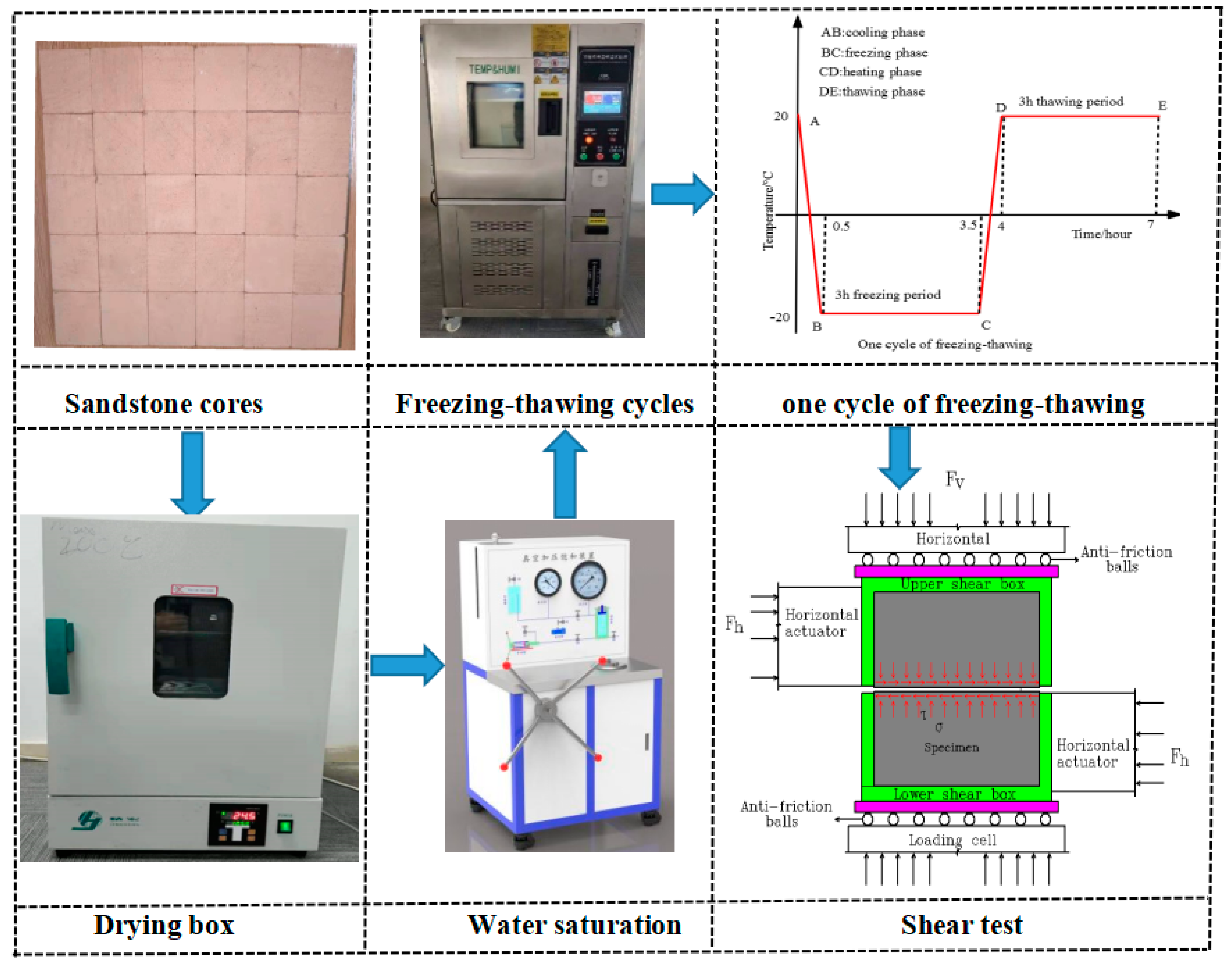
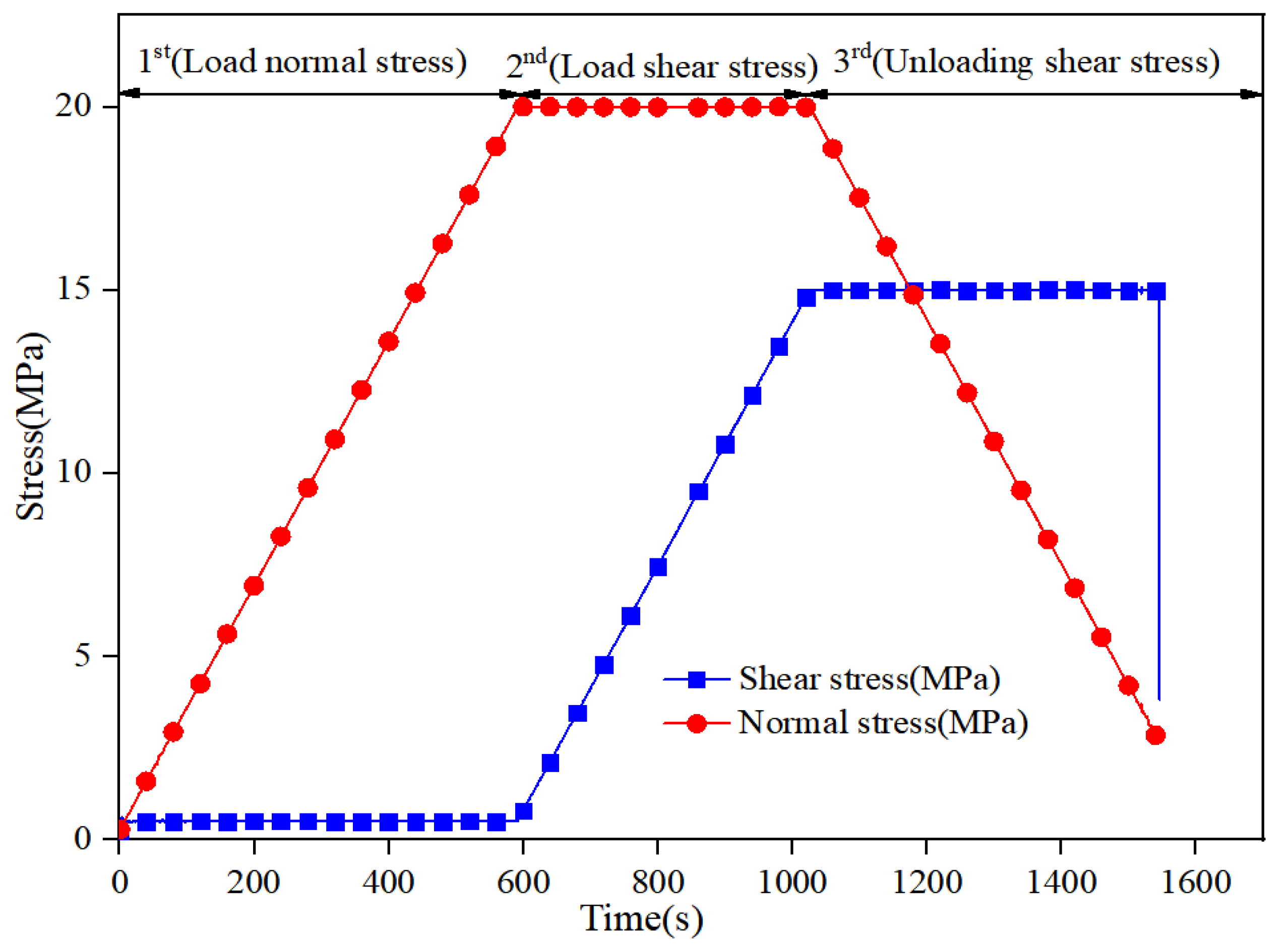
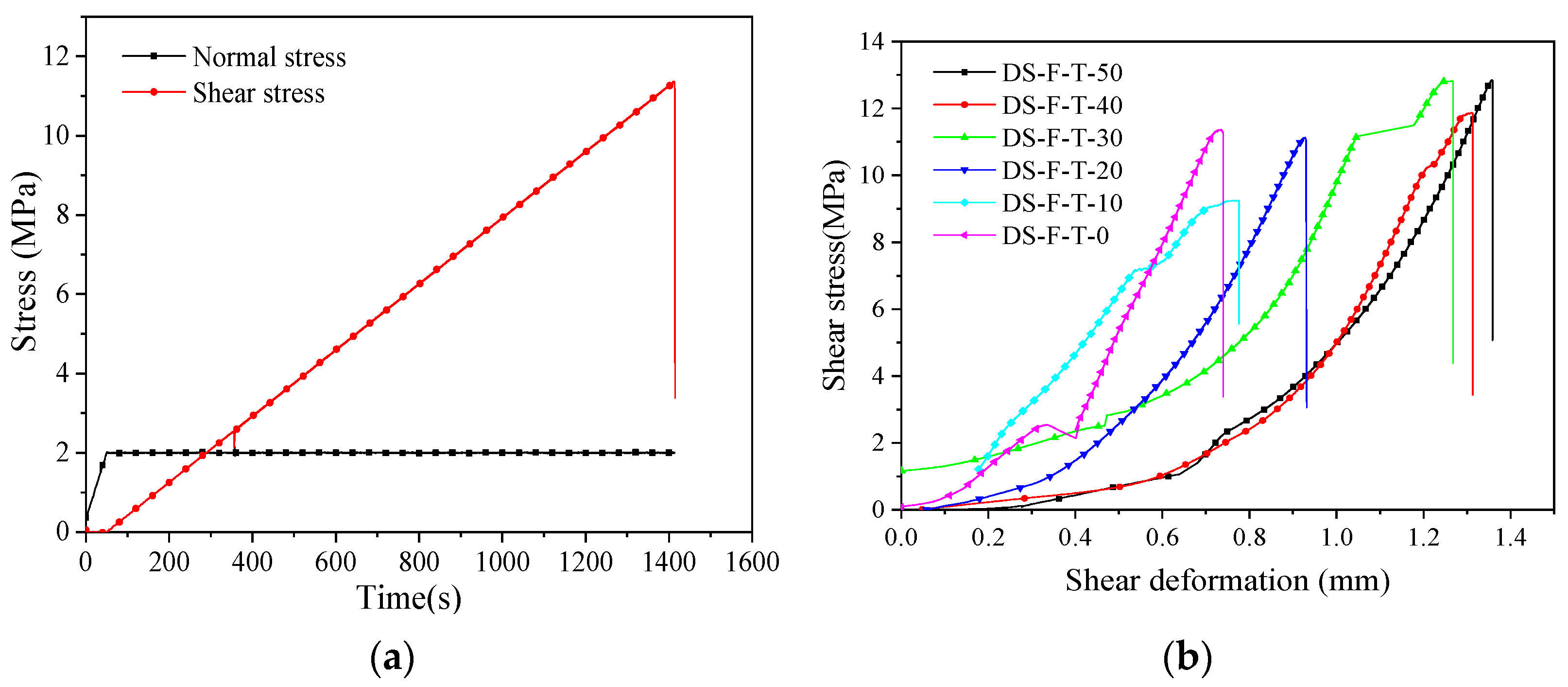

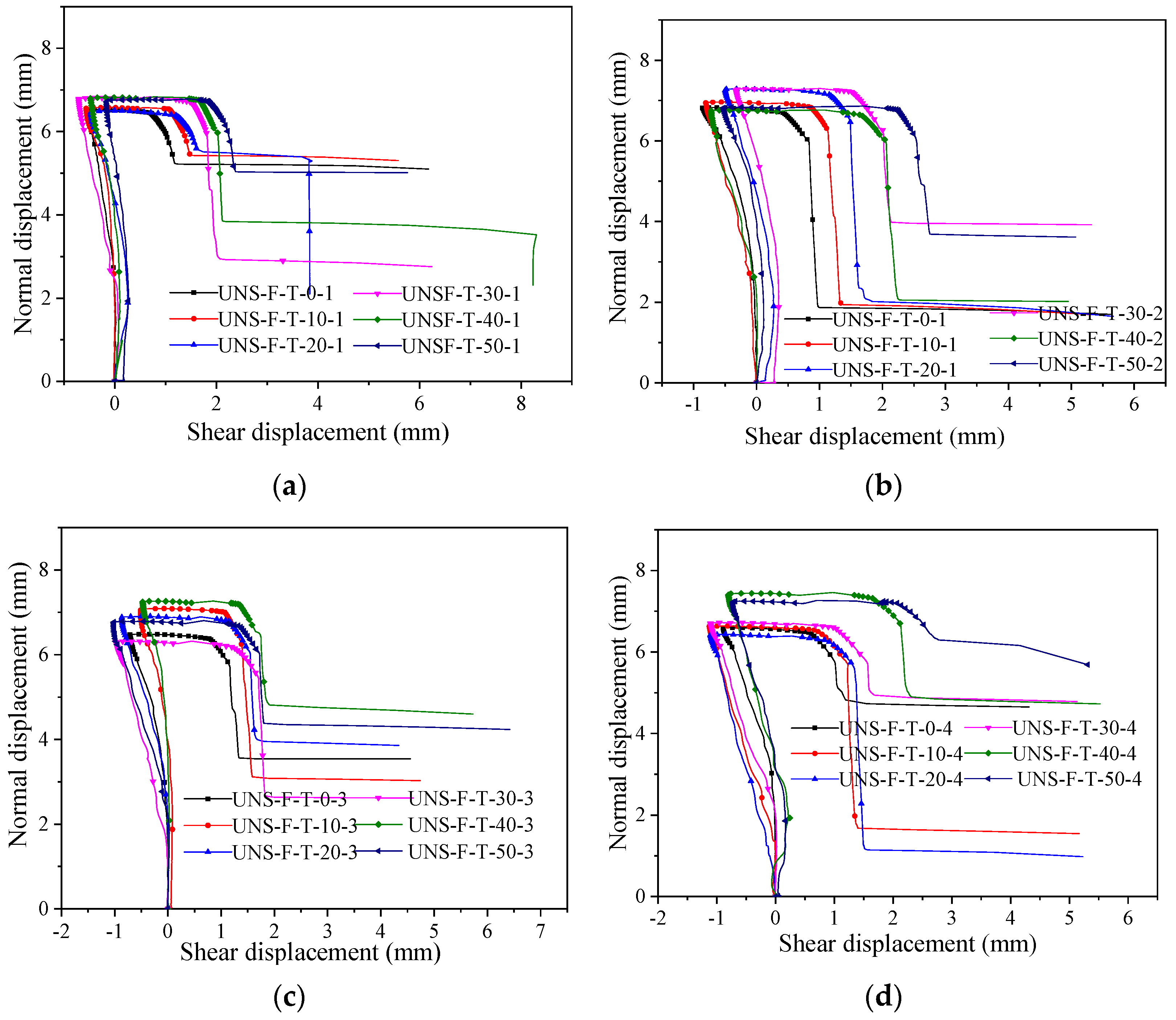
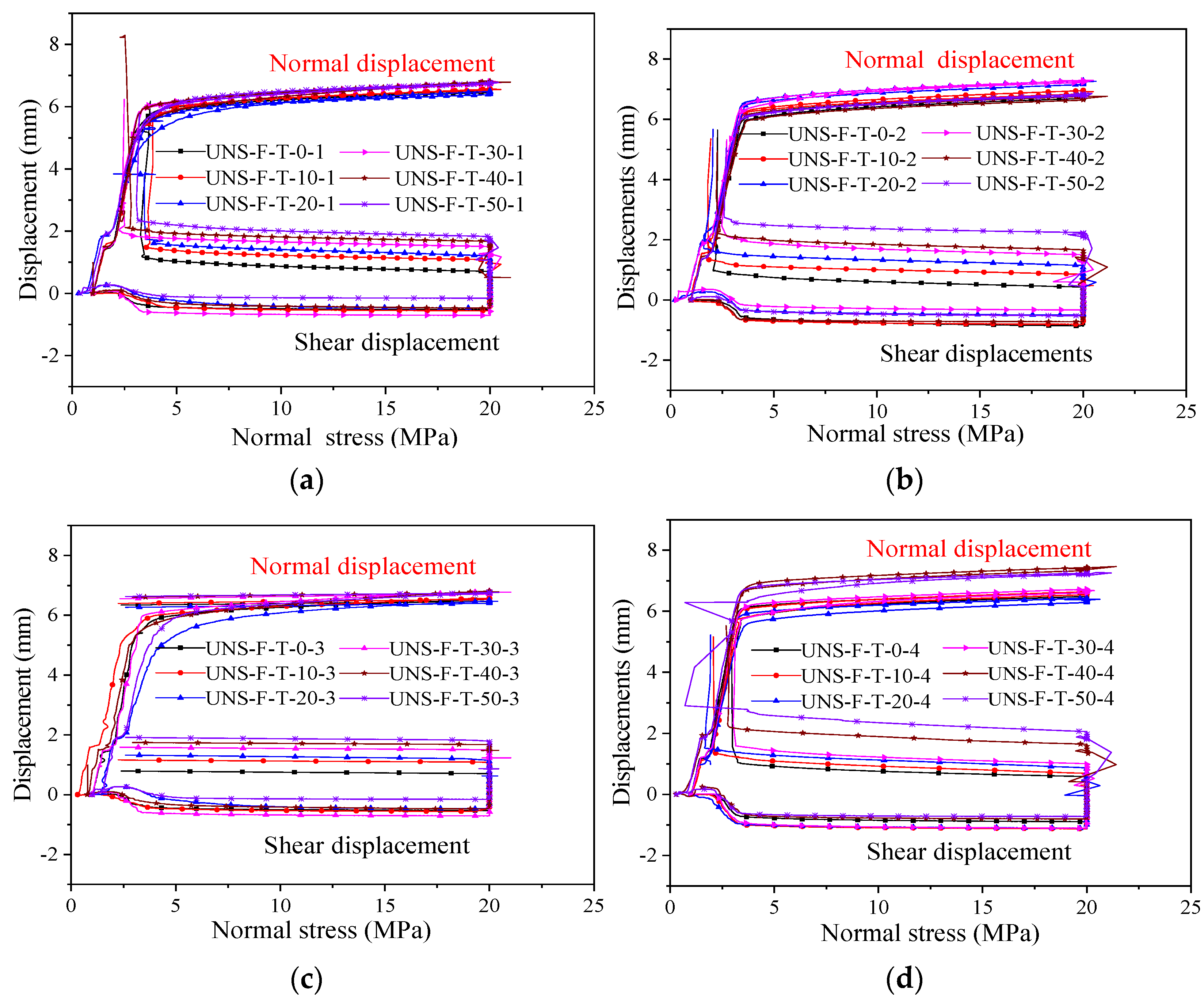
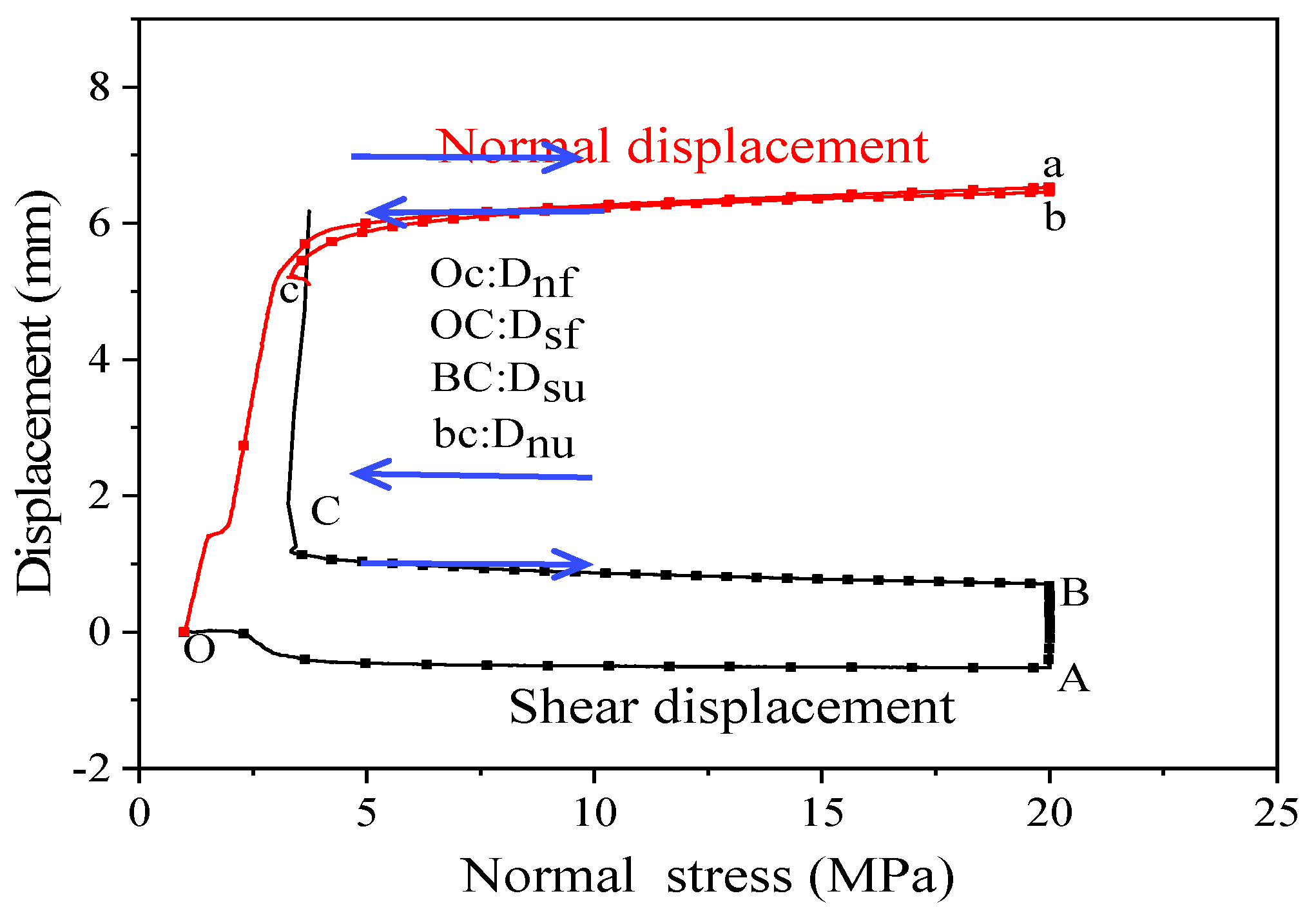
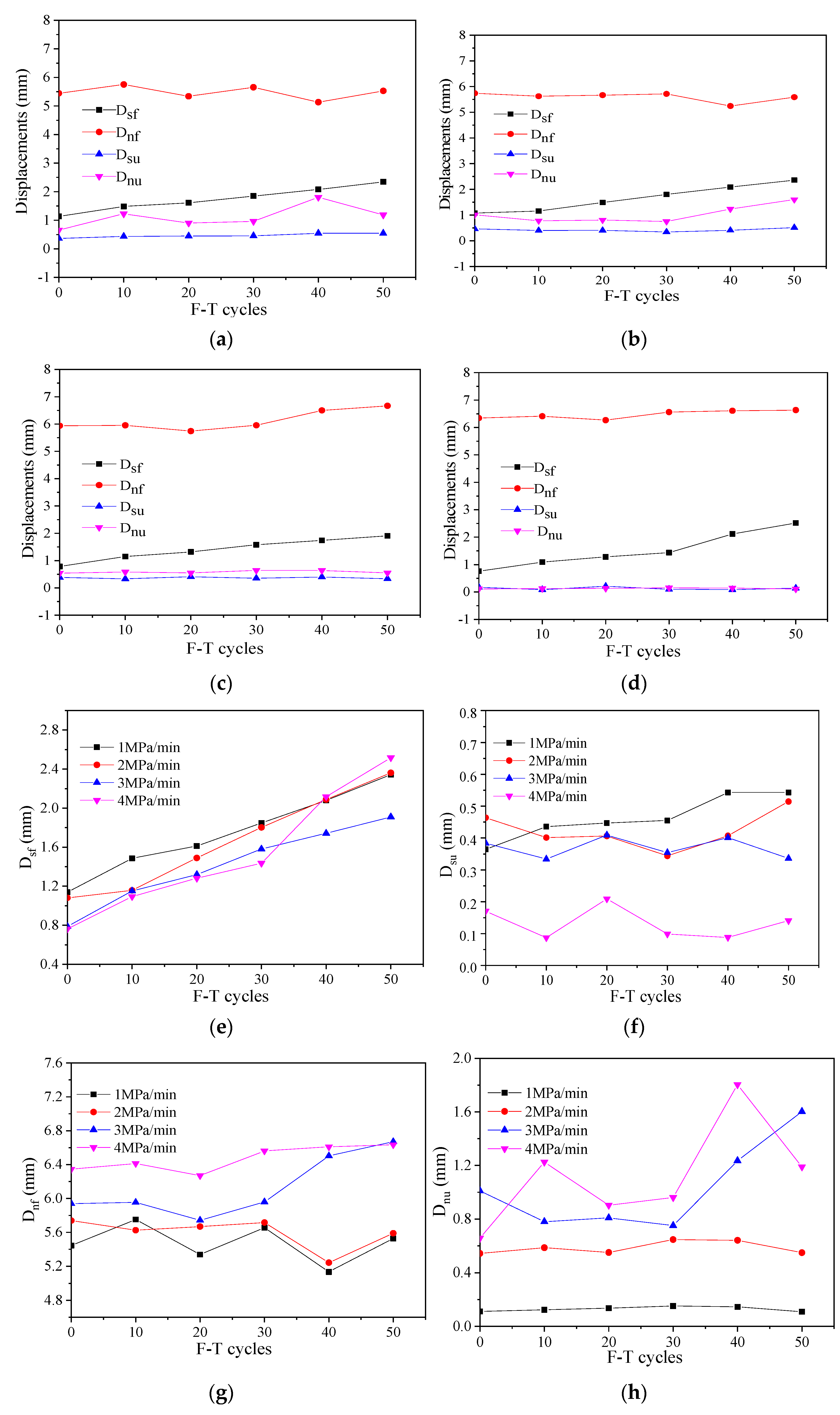

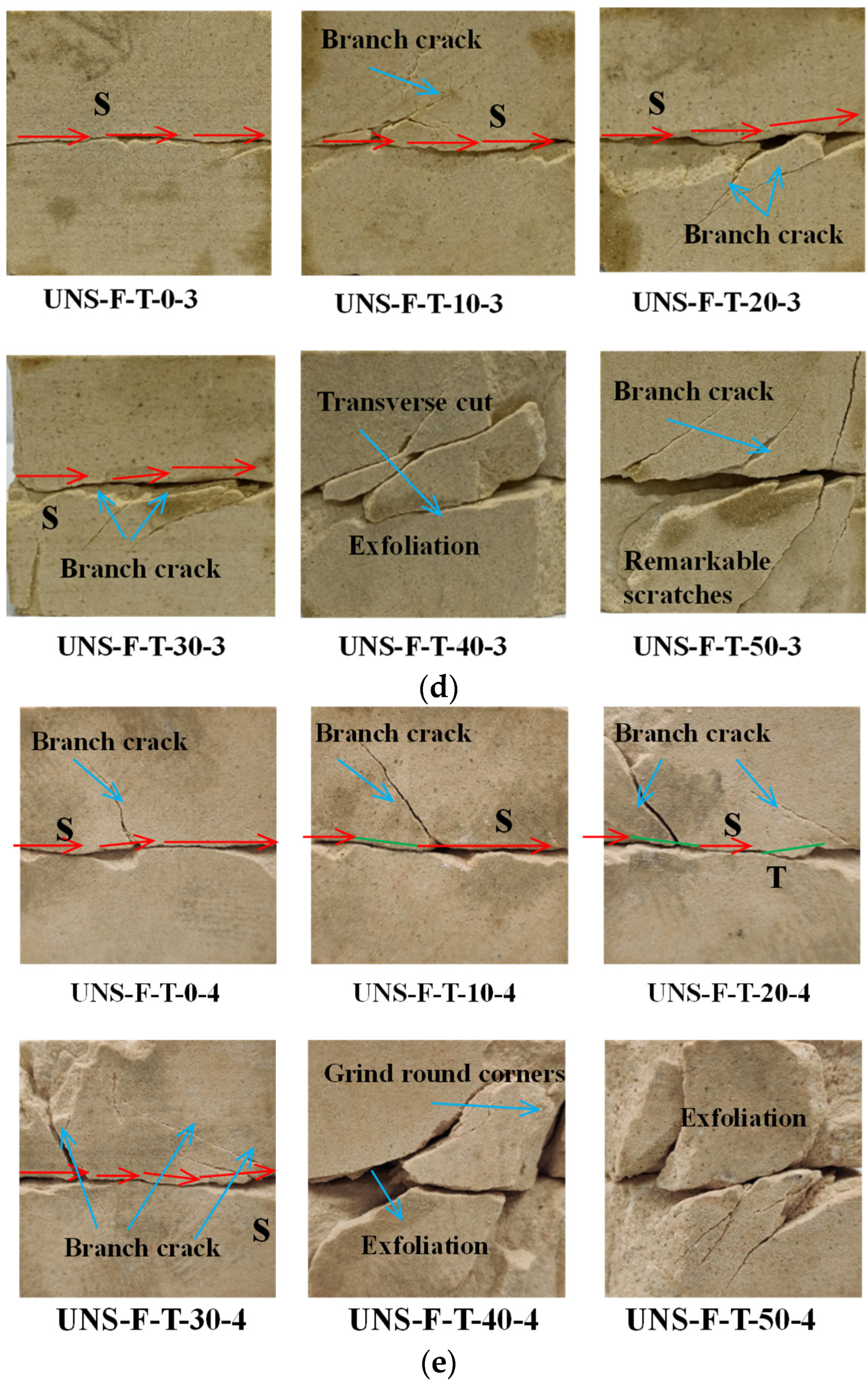
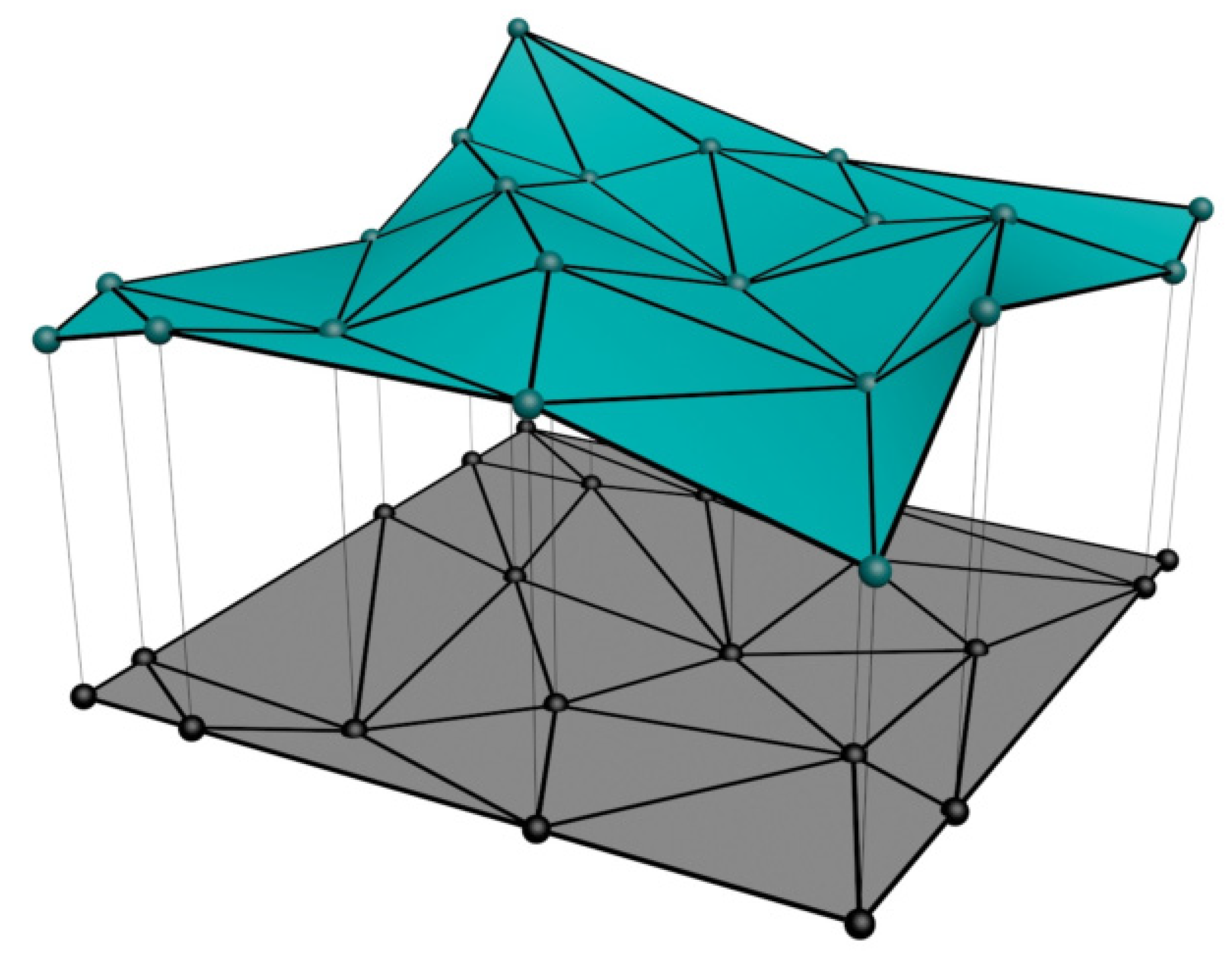

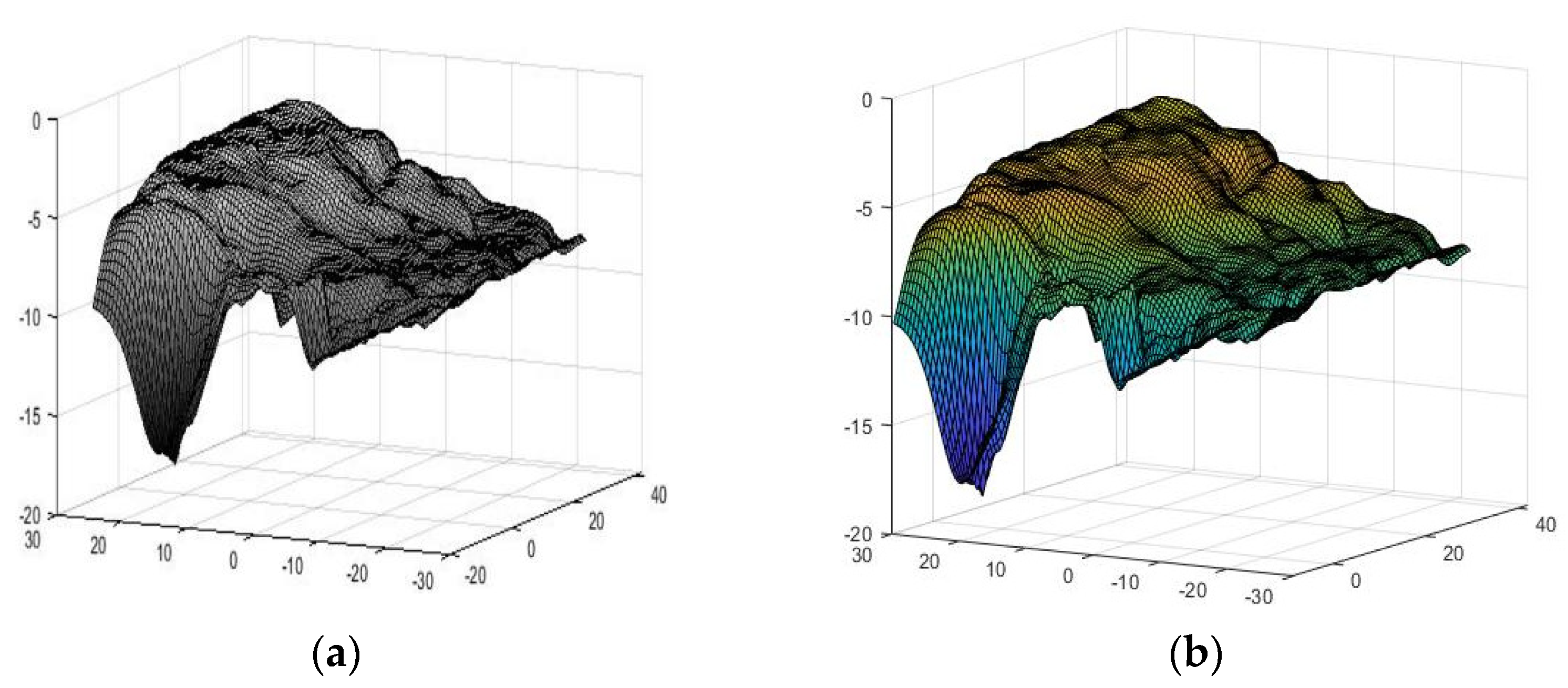
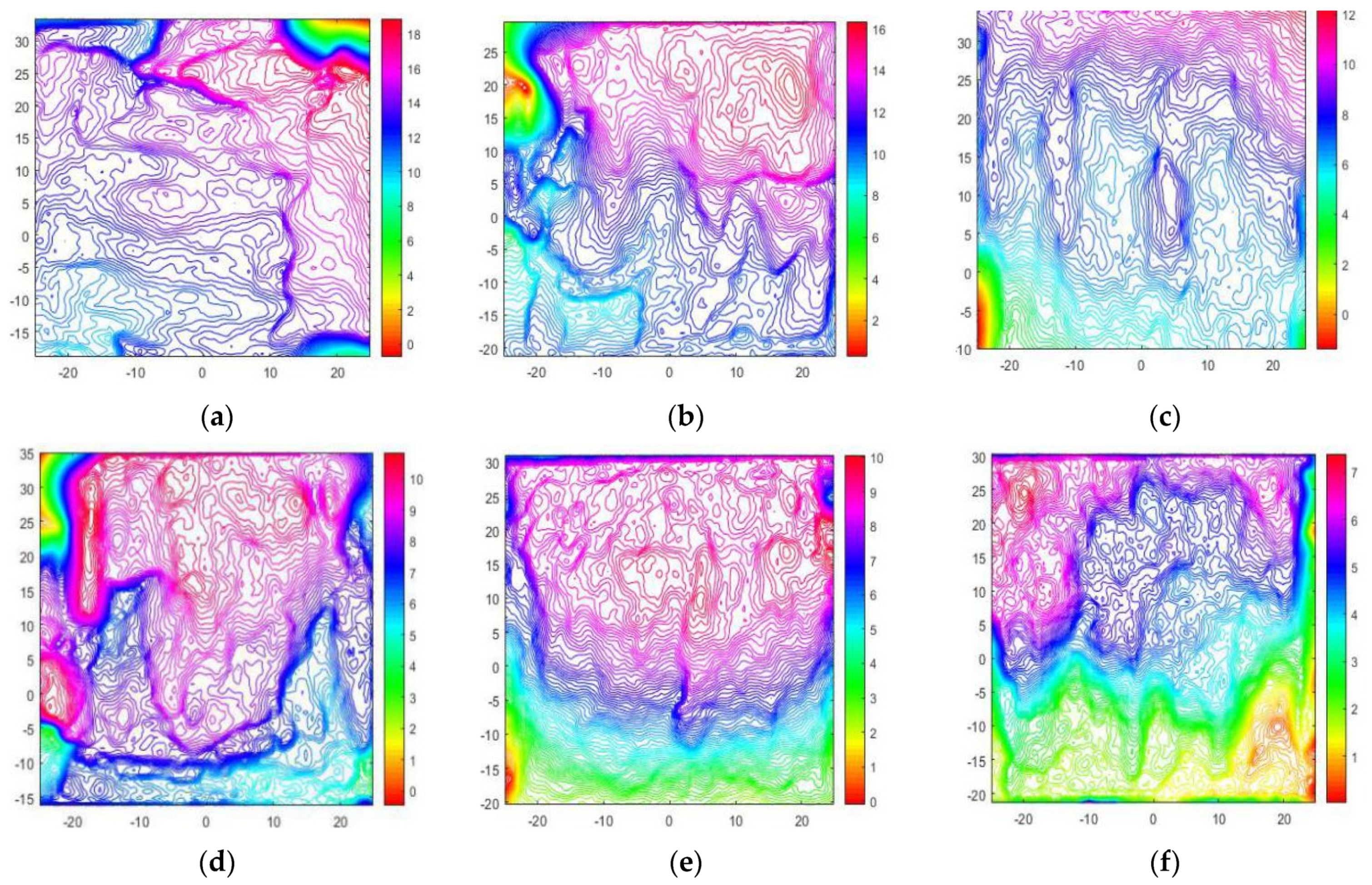
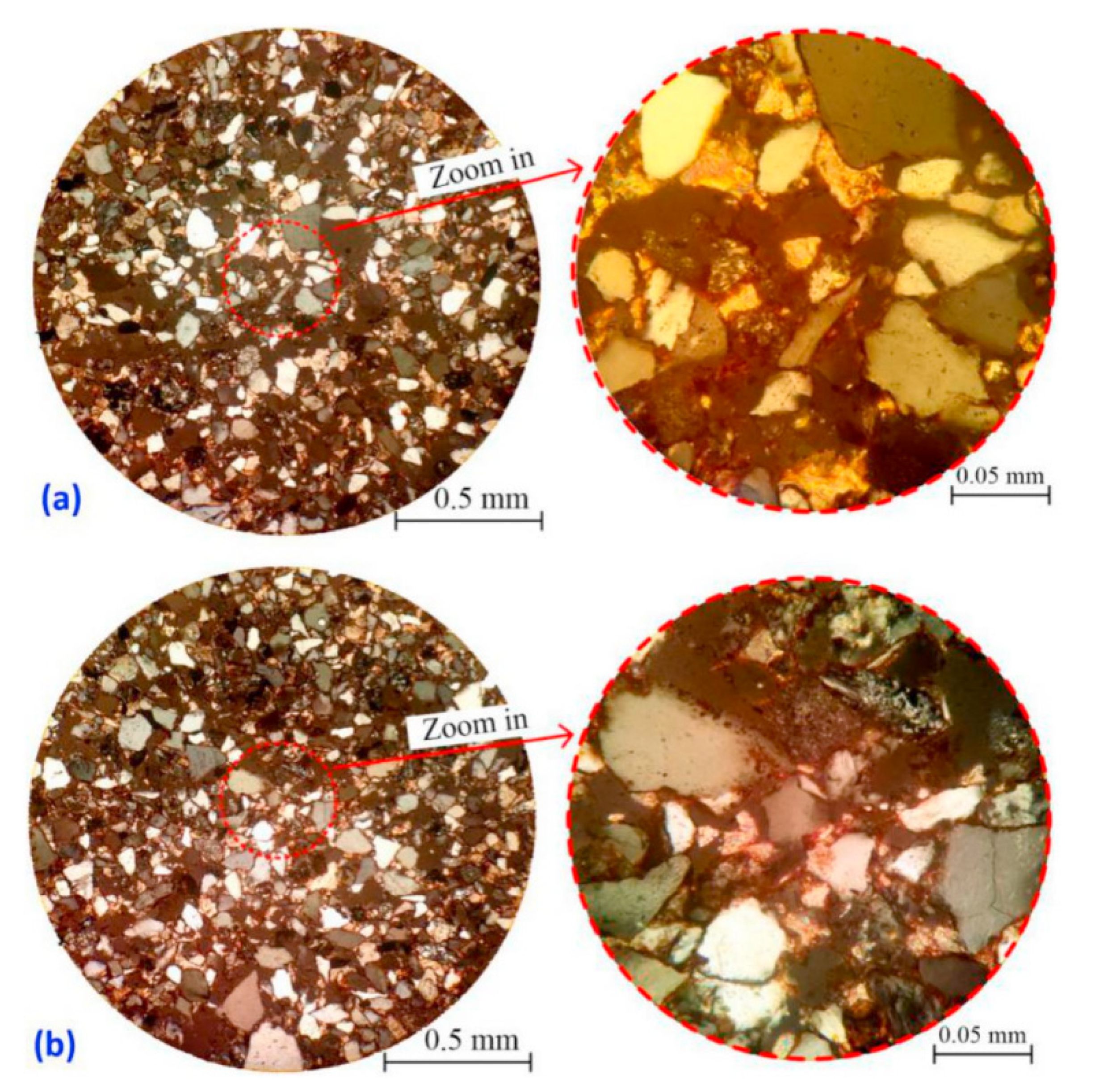
| Test | Freeze–Thaw Cycles | Unloading Rate | Samples | |||||
|---|---|---|---|---|---|---|---|---|
| Direct shear test (DS) | 0 | 10 | 20 | 30 | 40 | 50 | DS-F-T-0 DS-F-T-10 DS-F-T-20 DS-F-T-30 DS-F-T-40 DS-F-T-50 | |
| Direct shear test under unloading normal stress (DSTUNS) | 0 | 10 | 20 | 30 | 40 | 50 | 1 MPa/min | UNS-F-T-0-1 UNS-F-T-10-1 UNS-F-T-20-1 UNS-F-T-30-1 UNS-F-T-40-1 UNS-F-T-50-1 |
| 2 MPa/min | UNS-F-T-0-2 UNS-F-T-10-2 UNS-F-T-20-2 UNS-F-T-30-2 UNS-F-T-40-2 UNS-F-T-50-2 | |||||||
| 3 MPa/min | UNS-F-T-0-3 UNS-F-T-10-3 UNS-F-T-20-3 UNS-F-T-30-3 UNS-F-T-40-3 UNS-F-T-50-3 | |||||||
| 4 MPa/min | UNS-F-T-0-4 UNS-F-T-10-4 UNS-F-T-20-4 UNS-F-T-30-4 UNS-F-T-40-4 UNS-F-T-50-4 | |||||||
| F-T | θS1 | Rs1 | TS1 | Z2S1 | θS4 | Rs4 | TS4 | Z2S4 |
|---|---|---|---|---|---|---|---|---|
| 0 | 11.7 | 1.09 | 1.031 | 0.45358 | 10.4 | 1.01 | 1.011 | 0.41336 |
| 10 | 12.3 | 1.14 | 1.042 | 0.36945 | 11.5 | 1.08 | 1.025 | 0.32647 |
| 20 | 14.2 | 1.38 | 1.054 | 0.31254 | 12.6 | 1.16 | 1.032 | 0.29825 |
| 30 | 16.1 | 1.44 | 1.068 | 0.28533 | 13.9 | 1.20 | 1.045 | 0.24066 |
| 40 | 18.5 | 1.68 | 1.073 | 0.21687 | 14.8 | 1.47 | 1.059 | 0.17424 |
| 50 | 19.7 | 1.86 | 1.089 | 0.17744 | 16.5 | 1.64 | 1.065 | 0.10685 |
Publisher’s Note: MDPI stays neutral with regard to jurisdictional claims in published maps and institutional affiliations. |
© 2021 by the authors. Licensee MDPI, Basel, Switzerland. This article is an open access article distributed under the terms and conditions of the Creative Commons Attribution (CC BY) license (https://creativecommons.org/licenses/by/4.0/).
Share and Cite
Lian, S.; Li, J.; Gan, F.; Bi, J.; Wang, C.; Zheng, K. Investigation of the Shear Mechanical Behavior of Sandstone with Unloading Normal Stress after Freezing–Thawing Cycles. Machines 2021, 9, 339. https://doi.org/10.3390/machines9120339
Lian S, Li J, Gan F, Bi J, Wang C, Zheng K. Investigation of the Shear Mechanical Behavior of Sandstone with Unloading Normal Stress after Freezing–Thawing Cycles. Machines. 2021; 9(12):339. https://doi.org/10.3390/machines9120339
Chicago/Turabian StyleLian, Shuailong, Jiashen Li, Fei Gan, Jing Bi, Chaolin Wang, and Kun Zheng. 2021. "Investigation of the Shear Mechanical Behavior of Sandstone with Unloading Normal Stress after Freezing–Thawing Cycles" Machines 9, no. 12: 339. https://doi.org/10.3390/machines9120339
APA StyleLian, S., Li, J., Gan, F., Bi, J., Wang, C., & Zheng, K. (2021). Investigation of the Shear Mechanical Behavior of Sandstone with Unloading Normal Stress after Freezing–Thawing Cycles. Machines, 9(12), 339. https://doi.org/10.3390/machines9120339






